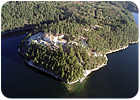
The Hardy Island quarry, located in the Jervis Inlet south of Powell River, British Columbia, opened in the early 1900s and reached its peak around 1915.
Haddington Island Stoneworks and Hardy Island Granite are continuing an historic tradition of stoneworking on Haddington Island. Measuring roughly a half-mile in diameter, this bucolic island is located in the Broughton Strait, off the northeast coast of Vancouver Island. The island rises 300 feet above sea level at its highest point, and Alert Bay, a regular port of call, is about four miles east of the island. The distance by water from Haddington Island to Vancouver is approximately 200 miles. At the same time, stone quarrying is also taking place on Hardy Island, located in the Jervis Inlet south of Powell River, British Columbia.
Materials from Haddington Island Stoneworks are fabricated and sold through Adera Natural Stone Supply of Burnaby, British Columbia, and Bedrock Granite Sales of Coquitlam, British Columbia, while stone from Hardy Island Granite Quarries is fabricated and sold through Bedrock Granite Sales.
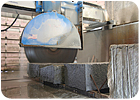
Blocks are offloaded at Bedrock Granite Facility, and the primary cutting is done using a Park Industries Eagle saw with an 11-foot-diameter blade.
Haddington Island history
Stone was first quarried from Haddington Island sometime in the early 1890s. Extensive quarrying appears to have started around 1895, and Haddington Island stone was first quarried to construct the parliament buildings in Victoria in 1896. That project gave Haddington Island stone a cache that lasted until preferences in architecture abruptly changed. For almost four decades, the quarry sat idle until it was reopened two years ago.In reopening the Haddington quarry, two separate stone supply companies decided to share the risk and all that goes with it. We combined our know-how, machinery and marketing skills. Also, our experience with Haddington Island stone showed it was comparable to Indiana limestone, one of the most popular stone building materials in the U.S. Haddington Island stone - officially an andesite, a class of volcanic rock named for the Andes - is distinguished by its density. The denser it is, the better it will hold an edge and the more frost resistant it will be. A geologist could tell you that an andesite’s almost microscopically fine grain is composed mostly of silica and plagioclase feldspar crystals. But like high-grade limestone, it can be worked into a finely detailed carving. It is also impressively durable. Before the Haddington Island quarry reopened in 2004, it had been deserted and all but forgotten since the 1950s. The last major building to use Haddington Island andesite was Vancouver’s City Hall, a Depression-era make-work project featuring a modern-style tower. In the postwar construction boom, steel and glass skyscrapers replaced imposing stone structures as the architectural signifiers of credibility. Labor-intensive stone went out of style, and the island quarry closed.
The quarry’s history had already had its turbulent moments. When work began on British Columbia’s parliament buildings in 1893, architect Francis Mawson Rattenbury - then a rising young star in the British Empire’s rising young colony - rejected other proposed materials for projects and decided on Haddington Island stone for the building’s richly carved facade. Problems arose between Rattenbury and project contractor Fredrick Adams when stone delivery from the island, located off the northeast coast of Vancouver Island, fell behind schedule. Adams assumed responsibility for the quarry himself, but costs and delays continued to rise. Finally, the architect retaliated by withholding part of Adams’ monthly payment, but this only made problems worse. Quarry workers, the Daily Colonist reported, were stuck on the island without money or food. By this point, Rattenbury and Adams could barely be in the same room without shouting at each other, and when Rattenbury sent his clerk to check on progress at the quarry, Adams knocked him down and threatened to kill both him and Rattenbury. The clerk pressed charges, and Adams was found guilty of assault and ordered to pay a $25 fine. Only two days later, barely out of the harbor at Victoria and starting back up the coast to Haddington Island, the contractor’s steam tug was shipwrecked in a sudden storm. Survivors clung to rocks off Trial Island, listening to the screams of dying men. Adams’ body was never found.
Of course, it wouldn’t be British Columbia history without labor unrest and a few horrific shipwrecks. But following these early setbacks, construction of the parliament buildings progressed smoothly. Rattenbury went on to a distinguished career designing such other prominent buildings as the Vancouver Courthouse, also built largely of Haddington Island stone.
Haddington Island stone has a velvety surface that fits with the rock’s soothing buff tones. The gentle color gives buildings constructed of the stone slight apparent warmth, which was noted in the federal government’s 1917 “Report on the Building and Ornamental Stones of Canada, Volume V”. This report, written by Wm. A. Parks, stated, “Viewed from a short distance, the buildings have a light yellowish-grey appearance, very pleasing to the eye.”
These days, the quarried stone is barged down the Strait of Georgia and up the Fraser River to Maple Ridge, where Bedrock Granite’s stone-cutting facility uses a Park Eagle saw to hew the pieces into more workable sizes before they are trucked to Adera Natural Stone Supply for further shaping. Most are destined to become cut-to-size architectural products such as windowsills, copings and cladding.
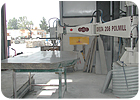
The EuroTech Delta Polmill 208 is used for polishing and texturing.
Hardy Island history
The Hardy Island quarry opened in the early 1900s and reached its peak around 1915, when it supplied the stone for the Ogden Point Breakwater in Victoria. This job, probably the largest dimension stone project in British Columbia history, was built using about 125,000 tons of squared blocks. The quarry shut down by the 1930s, and it was inactive until 1999, when Hardy Island Granite Quarries Ltd. reopened it. Today, the Hardy Island quarry is the only quarry producing granite blocks in British Columbia and the Pacific Northwest.Back in 1916, about 100 men were employed in the quarry. Quarrymen earned $3.75 per eight-hour day, while laborers earned $3.00 per eight-hour day and engineers earned $4.25 per eight-hour day.
The well-developed rift and grain of the site makes it feasible to quarry the old-fashioned way, using black powder. A burner is used to create a free face back to a joint, and then one or two holes on the rift or grain charged with black powder is sufficient to loosen a large block, which is then split up using feathers and wedges. Except for the burner and the use of a hoe and wheel loader rather than cranes, the methods used are very close to those used at the turn of the century.
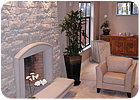
The finished products are used for a broad range of applications.
Extraction
Although channeling methods may have been used in the past, drilling and blasting with black powder is currently used to quarry all stone. In a quarry of this type, where the beds and joints are steeply inclined and the faces are over 100 feet high, most of the holes have to be drilled at angles of about 45 degrees. Thus, it has been found more convenient to quarry the stone by simple drilling and blasting. However, to ensure a clean break in quarrying the stone and in subdividing the large quarried blocks, it is the usual practice to drill all holes on 5- or 6-inch centers to the full depth of the blocks concerned. Approximately 30% of the stone quarried is eventually discarded as waste, with the greater part coming from the upper section of the quarry face near the surface.Quarry machinery includes a Caterpillar 988 loader with forks, a 4500 Mantower crane, marine bar drills, a Hitachi 400 Excavator, a 6 x 6, 20-ton former army truck, a fuel truck and a tug and barge. The overall quarry capacity is 100,000 cubic feet.
Both Haddington Stone and Hardy Island granite are barged down to Vancouver - a distance of approximately 250 miles - in 2,000- to 3,000-ton loads. Blocks are offloaded at Bedrock Granite’s facility, and the primary cutting is done using a Park Industries Eagle saw with an 11-foot-diameter blade. A Park Predator saw is also used for cutting blocks.
Both full stone and thin veneer is processed on Bedrock’s Park HydraSplit and the Park Industries Thin Stone TXS system.
Hardy Island granite is available in both random- and square-cut tumbled thin veneer. Haddington is available in split-face random ledgestone and sawn top and bottom ledgestone.
For cut-to-size architectural work, the materials are shipped to Adera Natural Stone Supply, which has established a state-of-the-art facility using all EuroTech machinery. This includes 5-axis CNC saws (EuroTech Delta 504 & 503), a EuroTech Delta Polmill 208 for polishing and texturing and the EuroTech Polmill 500 for coring. The facility also has a 10-ton overhead crane.
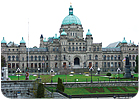
The British Columbia Parliament Buildings in Victoria, Canada, were built with Haddington Island andesite in 1886.
Special conditions
Both quarries are located in a fairly remote part of Canada. Quarrying has both its advantages and disadvantages. When it comes to shipping stone, barging is reasonable, as the distance from the quarry to the processing plant is about 250 miles, and it works out to about $20 per ton. However, getting to and from loading the stone and breakdowns can be extremely difficult. Winds from 30 to 40 knots and 6- to 8-foot swells make the going tough, if not impossible, at times. But on a good day, there is nothing like it - water like glass; eagles up above; and if you’re lucky, a whale or two going by.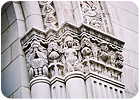
The building’s entrance showcases the fine carving ability and durability of the material.
Finished products/markets
Finished products in granite and andesite include: 4- to 6-inch wall stone in random/ashlar patterns, 2- to 6-inch ledgestone, slabs ranging from ½ to 12 inches in thickness, cut-to-size cladding, thresholds, window surrounds, landscape stone, etc; flamed, bushhammered and tumbled pavers; flamed brushed and striated tiles; flagstone; monumental pieces; and other stonework.The company serves a range of markets. In addition to British Columbia, products are sold in Alberta, Canada and Washington, Oregon and California in the U.S. Ongoing projects include several high-end residential applications, the Air India Monument in Vancouver in Stanley Park and both local universities.
